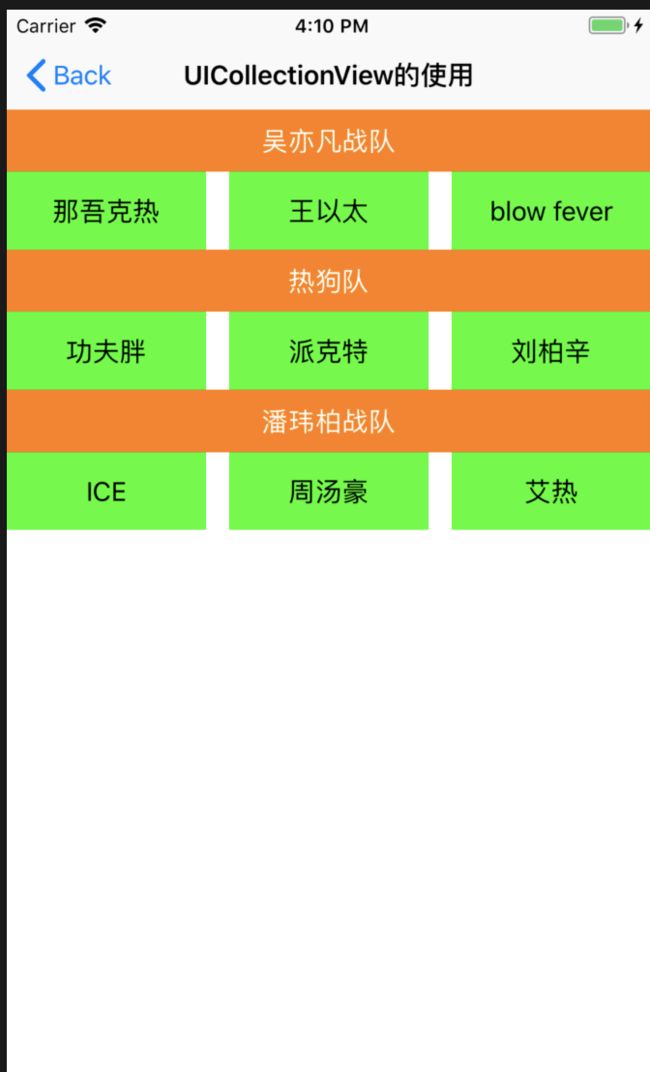UITableView和RxDataSources基本使用
RxDataSources使用 RxSwift 对 UITableView 和 UICollectionView 的数据源做了一层包装。配合起来使用UITableview更方便
RxDataSources下载
本文demo下载
1、基本使用
(1)创建datasource
//不分组
let items = Observable.just(
[SectionModel(model: "",
items: ["UILabel的使用","UIbutton的使用","UIText的使用"])
])
let dataSouce = RxTableViewSectionedReloadDataSource>(configureCell:{ (dataSouece, tv, indexPath, element) -> UITableViewCell in
let cell = tv.dequeueReusableCell(withIdentifier: "cell")!
cell.textLabel?.text = element
cell.selectionStyle = .none
return cell
})
分组的形式,初始化多个SectionModel数据即可
//初始化数据
let items = Observable.just([
SectionModel(model: "基本控件", items: [
"UILable的用法",
"UIText的用法",
"UIButton的用法"
]),
SectionModel(model: "高级控件", items: [
"UITableView的用法",
"UICollectionViews的用法"
])
])
//设置分区头标题
dataSource.titleForHeaderInSection = { ds, index in
return ds.sectionModels[index].model
}
(2)设置代理、绑定数据
tableView.rx.setDelegate(self)
.disposed(by: disposeBag)
items.bind(to: tableView.rx.items(dataSource: dataSouce))
.disposed(by: disposeBag)
(3)设置高度
func tableView(_ tableView: UITableView, heightForRowAt indexPath: IndexPath)
-> CGFloat {
return 60
}
区头可以自己修改,写法和普通Swift即可,通过tableview的代理修改区头区尾样式,设置高度
2、cell点击事件
//获取索引
tableView.rx
.itemSelected
.subscribe(onNext: {indexPath in
//print("选中项的indexPath为:\(indexPath)")
})
.disposed(by: disposeBag)
//获取选中项的内容,item为dataSource的改单元格数据
tableView.rx.modelSelected(String.self).subscribe(onNext: {[weak self] item in
self?.showMessage("选中项的标题为:\(item)")
}).disposed(by: disposeBag)
3、cell其他事件
RxDataSource删除数据源
dataSouce.canEditRowAtIndexPath = {item,indexPath in
if indexPath.row == 0 {
return true
}
return false
}
删除
tableView.rx
.itemDeleted
.subscribe(onNext:{indexPath in
print("\(indexPath)")
})
.disposed(by: disposeBag)
移动
tableView.rx
.itemMoved
.subscribe(onNext: { (sourceIndexPath, destinationIndexPath) in
//
})
.disposed(by: disposeBag)
取消选择
tableView.rx.itemDeselected.subscribe(onNext: { indexPath in
//
}).disposed(by: disposeBag)
//尾部视图点击
//获取点击的尾部图标的索引
tableView.rx.itemAccessoryButtonTapped.subscribe(onNext: { indexPath in
//
}).disposed(by: disposeBag)
4、数据刷新
不需要手动去调用reloadData,数据和tablview绑定即可.
(1)数据获取
let dataSource = refreshButton.rx.tap.asObservable()
.throttle(1, scheduler: MainScheduler.instance) //在主线程中操作,1秒内值若多次改变,取最后一次
.startWith(()) //加这个为了让一开始就能自动请求一次数据
.flatMapLatest(getData)//只会接收并显示最后一次请求
.share(replay: 1)
(2)数据请求、返回
func getData() -> Observable<[SectionModel]> {
print("正在请求数据......")
let items = (0 ..< 5).map {_ in
Int(arc4random())
}
let observable = Observable.just([SectionModel(model: "S", items: items)])
return observable.delay(2, scheduler: MainScheduler.instance)
}
UICollectionView
UICollectionView使用上和UITableView差不多,也是结合RxDataSources使用。
1、基本使用
(1)创建dataSource
通过RxDataSources进行创建
let items = Observable.just([
SectionModel(model: "吴亦凡战队", items:
["那吾克热","王以太","blow fever"]),
SectionModel(model: "热狗队", items:
["功夫胖","派克特","刘柏辛"]),
SectionModel(model: "潘玮柏战队", items:
["ICE","周汤豪","艾热"]),
])
let dataSource = RxCollectionViewSectionedReloadDataSource>(
configureCell: { (dataSource, collectionView, indexPath, element) -> UICollectionViewCell in
let cell : CollectionCell = collectionView.dequeueReusableCell(withReuseIdentifier: "cell", for: indexPath) as! CollectionCell
cell.label.text = element
return cell},
configureSupplementaryView: {(dataSource ,collectionView, kind, indexPath) in
let section = collectionView.dequeueReusableSupplementaryView(ofKind: kind,
withReuseIdentifier: "Section", for: indexPath) as! SectionHeader
section.label.text = "\(dataSource[indexPath.section].model)"
return section}
)
(2)设置代理,进行数据绑定
属性设置,cell的注册
let flowLayout = UICollectionViewFlowLayout()
flowLayout.itemSize = CGSize(width: 100, height: 70)
flowLayout.headerReferenceSize = CGSize(width: self.view.frame.width, height: 40)
self.collectionView.setCollectionViewLayout(flowLayout, animated: true)
self.collectionView.register(CollectionCell.self, forCellWithReuseIdentifier: "cell")
self.collectionView.register(SectionHeader.self, forSupplementaryViewOfKind: UICollectionElementKindSectionHeader, withReuseIdentifier: "Section")
数据绑定
items.bind(to: collectionView.rx.items(dataSource: dataSource))
.disposed(by: disposeBag)
collectionView.rx.setDelegate(self)
.disposed(by: disposeBag)
选中事件(还有很多事件都大致相同)
collectionView.rx.modelSelected(String.self).subscribe(onNext:{item in
print("为\(item)投上一票")
})
.disposed(by: disposeBag)
代理的写法都和Swift的相同

